
“Coastal Post Office” by artist Stevan Dohanos published by the “Saturday Evening Post” magazine on August 26th, 1950. Click for this painting in various sizes of canvas wall art.
Yet despite the technological changes that have swirled around this seemingly “old world” communication system in recent decades — and the sometimes carping about rising postage, slow service, or overpaid workers — the U.S. Post Office is still highly regarded in the American community.
Whether remote rural outpost or big-city neighborhood branch, the local U. S. Post Office is still a much-loved part of the American scene, and a key community institution. And over the years, in the nation’s cultural tableau and social register, the local Post Office has been portrayed fondly as a valued place and integral part of the community.
Take, for example, how the Saturday Evening Post magazine portrayed a local post office scene on one of its covers from August 26, 1950. This rendering, shown at right, by artist Stevan Dohanos (1907- 1994), is titled “Coastal Post Office.” It portrays the “Menemsha Post Office” – an actual place on Martha’s Vineyard Island, MA.

Detail from Stevan Dohanos’ “Coastal Post Office.”
A close-up portion of Dohanos’ painting displayed at left reveals a bit more detail about the postal patrons and the services being offered — a woman reading her mail on the way out; signs in the post office window announcing, “Skiffs Rented” and “Home Baked Goods,” and another higher up for a local “bake” of some kind on “Friday.” True to form, and as suggested by Dohanos in this rendering, the thousands of local post offices that stood across mid-20th century America were active community hubs — and many remain so today. Thousands of post offices that stood across mid-20th century America were and still are active community hubs. Then and now, they have been and continue to be important gathering places and information centers, offering multiple services beyond just the mail, also as Dohanos relayed of Menemsha in 1950.
Those were surely the halcyon days of the U.S. postal system; a time when letter writing, mail, and the local post office were all a more central part of everyday American life. Yet still today, the U.S. Post Office system is a major player in American communities and the American economy. In 2010 it had revenues of $67 billion, which if it were a private company, would place it at roughly No. 29 on the Fortune 500 list. The U.S. post office system has more domestic locations – i.e., some 31,800 post offices – than Walmart, Starbucks, and McDonald’s combined. And despite the system’s current financial woes and the rapidly changing nature of information culture, the long-standing community place known as the local post office is still a welcomed and valued presence in many communities.
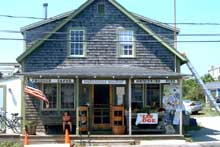
Recent photo, Menemsha Post Office.
The structure, shown at left, appears somewhat differently than it did in the time Dohanos did his rendering more than 60 years ago, but the resemblance is still there. A story about its local operation and one of its long-time postmasters and store owners appears as a link in “Sources” below. It is not known, however, if the Menemsha Post Office is on the latest list of targeted post office closings.
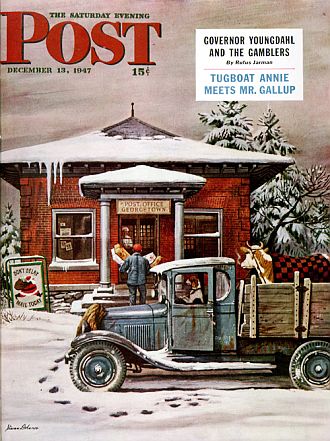
A Stevan Dohanos illustration, “Rural Post Office at Christmas,” provides seasonal cover art for Saturday Evening Post of December 13, 1947. Click for illustration in various sizes of canvas wall art.
A somewhat crisper portion of this Dohanos painting, displayed below, reveals a bit more detail in the scene. A sign on the ground at the corner of the post office building features a Santa Claus on the move with mail sack over his shoulder, also bearing the seasonal admonition: “Don’t Delay, Mail Today.”
Through the doorway, an older man in a white shirt can be seen, likely the postmaster waiting to help with the packages. Behind the postmaster, and beyond the doorway, rows of postal boxes can be seen. Also visible through the window at left, and tacked to a wall, are various notices and announcements.
Prints of this particular Dohanos painting – both in its Saturday Evening Post edition, and as the painting by itself – can be found for sale online. The painting used for the Saturday Evening Post cover was offered for sale at Sothebys in March 2010 with an estimated price of between $15,000 and $20,000.
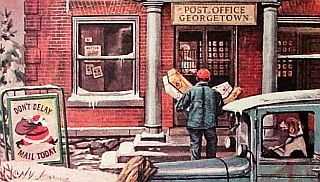
Detail from "Rural Post Office at Christmas," S. Dohanos.
Dohanos also worked for Esquire and Medical Times magazines and provided advertising art for Caterpillar, Four Roses Whiskey, Maxwell House coffee, Pan Am airlines, Cannon Towels, Olin Industries, John Hancock Insurance, and others. In addition, Dohanos illustrated WWII posters, did Christmas Seal art, film art for White Christmas, and also wall murals for a number of federal buildings from West Virginia to the Virgin Islands.
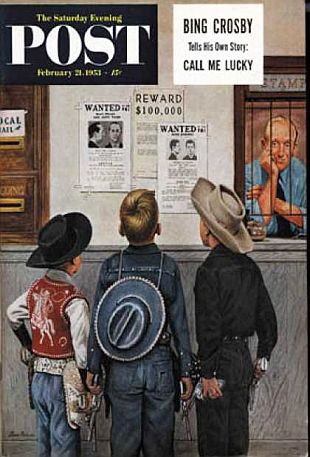
“Wanted Posters,” cover scene title for the February 21, 1953 Saturday Evening Post, by artist Stevan Dohanos. Click for cover.
The boys in this rendering appear somewhat in awe of what they are viewing and reading. They have apparently taken a break from their play, and wandered into the free and open lobby of the local post office, deciding to take a look at the posted information on the nation’s real criminal element. They are not likely contemplating a try for the reward money, but perhaps they may add to their play fantasy by what they read. And who knows, maybe one of them might even be inspired to go into criminal justice work.
But surely, such cold and stark “money-on-your-head” public postings must have helped make real for this young band of play bandits that a life of crime might not be all that glamorous. Meanwhile, the postal worker at the stamp window in this scene is watching the boys with seemingly amused approval.

Detail from “Wanted Posters” reveals that one of the offenders is wanted for “mail fraud” the other “bank robbery.”
Mailmen & The Mail
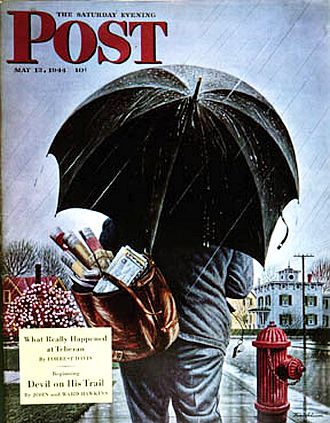
“Mailman” cover for May 13th, 1944 edition of Saturday Evening Post by Stevan Dohanos. Click for book about Dohanos and his art.
The U.S. Postal Service currently has something on the order of 570,000 full-time workers, making it the country’s second largest employer. All of these folks are not letter carriers, or course, as many work in various other parts of the mail system. Still, only Wal-Mart employs more people in the U.S. than the Postal Service. And the U.S. mail system still handles an enormous amount of “product.”
As of 2010, the U.S. Postal Service was delivering an average 560 million pieces of mail each day; more than 170 billion annually, accounting for about 40 percent of all global mail. However, in recent years, the composition of the U.S. mail bag has been changing in major ways. In the late 1970s, for example, Congress prevailed upon the Postal Service to allow private companies to carry letters needing urgent delivery. As a result, Federal Express and the United Parcel Service (UPS) built enormously valuable businesses on what was once Post Office turf. Today, UPS and FedEx have respectively 53 and 32 percent of the American express and ground-shipping market, while the Postal Service has about 15 percent.
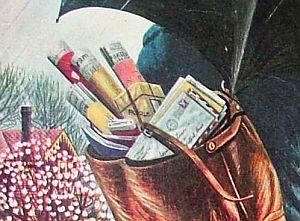
“Mailman” detail – What’s in the U.S. mail sack today?
By 2005, junk mail had surpassed first-class mail for the first time. Yet junk mail, per piece, is only a third as valuable as a first-class letter. And junk mail rises and falls with the vagaries of the economy. Recently in the U.S., when times were flush with booming real estate sales and easy credit, banks deluged mailboxes with mortgage deals and credit-card offers. But when the recession hit in 2006-2010, total mail volume plunged 20 percent.
Stamp Collecting
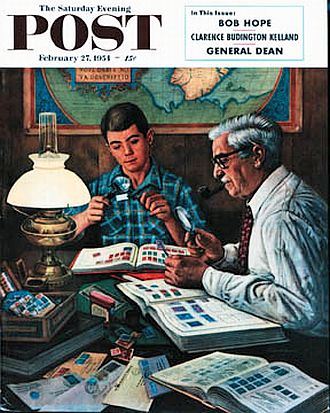
Stevan Dohanos did this “Stamp Collecing” cover for the Saturday Evening Post of February 27, 1954.
|
“Stevan Dohanos” 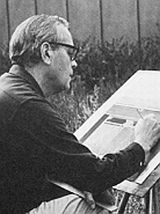 Photograph of Artist Stevan Dohanos at work, undated. 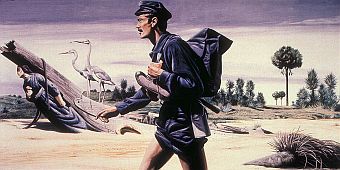 “Legend of James Hamilton--Barefoot Mailman” (mural study, West Palm Beach Post Office), 1940, S. Dohanos, panel 2. Click for novel.  Stevan Dohanos helped design this 1967 JFK stamp. Stevan Dohanos’ paintings today can be found in the collections of the Avery Memorial of Hartford, The Cleveland Museum, New Britain Museum of American Art, the Pennsylvania Academy of the Fine Arts, and the Whitney Museum of American Art. |

“The End of Mail” cover story illustration, Bloom-berg Business Week, May-June 2011.
Today’s magazine cover art featuring the U.S. Postal system has not been in the tradition of those old Saturday Evening Post covers capturing community bustle at a picturesque post office in a coastal town, or of Christmas cheer a-coming in December’s mail. Rather, today’s magazines are now focused on the financial side of the story, as Bloomberg Business Week did with its May-June 2011 cover story displayed at left.
Yet for millions of Americans there is still something of the Stevan Dohanos and Saturday Evening Post imagery and vitality that survives in today’s real world postal system – and a longing among many that something like it should survive into the future. But how to do that has been the major problem facing Congress and country in recent years, as a variety of bills proposing major changes have been offered and debated. And as this is written in September 2011, more than 3,600 U.S. Post Offices across the land have been slated for shut down.

Yvonne Rennolds stops by the Arrow Rock, Arkansas post office in August 2011 to get her mail and bring postmaster Tempe McGlaughlin a container of pasta salad. The post office is among those slated for closing. Sarah Hoffman.
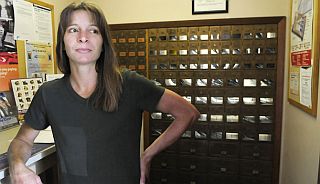
Kim Billington of Waverly, WA, a city council member, at her town's post office which serves 100 residents in southern Spokane County. Billington says the post office is the only building in town that is staffed every day. Photo, AP.
Paring down far-flung networks and centralizing services may seem an efficient accounting at the moment. Yet if it costs the nation citizen connectedness today and imposes a future capital replacement cost tomorrow, isn’t that really a false economy? Rather, if a network of connectedness exists out there now, why take it apart? Why dismantle something that connects people to their government, is in place now, and can serve the future?
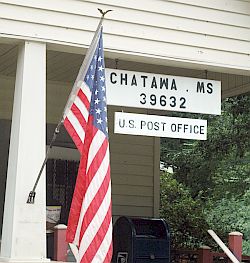
Some 60 post offices may close in Mississippi...
Additional stories at this website on magazine history and magazine cover art can be found at the “Magazine History” topics page, which includes, for example: “FDR & Vanity Fair,” (cover art & politics); “Murdoch’s NY Deals” (New York magazine history); “Remington’s West” and “Christy Mathewson” (John Hancock magazine ads); and “Rockwell & Race” (cover art & civil rights). See also the “Politics & Culture” page for stories in that category. Thanks for visiting — and if you like what you find here, please make a donation to help support the research and writing at this website. Thank you. — Jack Doyle
|
Please Support Thank You |
____________________________________
Date Posted: 29 September 2011
Last Update: 25 December 2020
Comments to: jdoyle@pophistorydig.com
Article Citation:
Jack Doyle, “The U.S. Post Office, 1950s & Today”,
PopHistoryDig.com, September 29, 2011.
____________________________________
Sources, Links & Additional Information
 February 22, 1936: “Reading Her Mail at the Greenville Post Office,” by artist Ellen Pyle for the Saturday Evening Post. |
 February 18, 1922: “Sorting The Mail,” by artist Norman Rockwell for the Saturday Evening Post. |
“Stevan Dohanos,” Artist Gallery, Curtis Publishing.com.
“S. Dohanos,” AmericanIllustration.org.
“Stevan Dohanos Biography,” Ilustration -House.com.
“Stevan Dohanos,” Wikipedia.org.
Stevan Dohanos, selected Saturday Evening Post covers, FullTable.com.
“The Saturday Evening Post, Stevan Doha-nos,” MyMags.com.
“U. S. Postal Service,” Wikipedia.org.
“Barbara F. Seward” (with photo), The Martha’s Vineyard Times, January 2011.
“Barbara Seward, Last Menemsha Post-master,” The Vineyard Gazette, January 14, 2011.
Devin Leonard, “The U.S. Postal Service Nears Collapse,” Bloomberg Business Week, May 30-June 5, 2011.
Sandra Taylor Smith and Mark K. Christ, “Arkansas Post Offices & Treasury Dept.’s Section Art Program, 1938-1942,” Arkansas Historic Preservation Program, 1500 Tower Building, 323 Center Street, Little Rock, AR 72201.
Lot 171, Stevan Dohanos, “Georgetown Post Office (Don’t Delay, Mail Today),” American Paintings, Drawings & Scuplture, Cata-logues, Sothebys, March 2010.
“History of Georgetown, Connecticut,” HistoryofRedding.com.
“U.S. Presidents on U.S. Postage Stamps,” Wikipedia.org.
Panel 2, Legend of James Edward Hamilton–Barefoot Mailman (mural study, West Palm Beach, Florida Post Office), 1940, Stevan Dohanos, Smithsonian Institution, Washington, D.C.
“Barefoot Mailman,” Wikipedia.org.
Stevan Dohanos, Artwork Sampler, Ameri-can Art Archives.
“Chronological Listing of the FBI’s ‘Ten Most Wanted Fugitives’,” FBI.gov.
“Stevan Dohanos, A Stamp Designer And Illustrator, 87,” New York Times, July 6, 1994.
Eleanor Charles, “Illustrator’s Works in Retrospective Opening Today,” New York Times, Connecticut Weekly Desk, Sunday, November 10, 1985, Section 11CN, p.32.
William Zimmer, Art; “Illustrator’s Show: ‘Images of America’,” New York Times, December 8, 1985.
Robert Hood, “Rural America Feels the Sting of Post Office Closings,” MSNBC.MSN.com, July 12, 2011.
Carly Mallenbaum, Postal Service lists 3,700 branches for possible closing,” USA Today, July 27, 2011.
Susan Meeker, “Grimes Community Hub on List of Possible U.S. Postal Service Closures,” Colusa County Sun-Herald (California), Friday, July 29, 2011.
Harry R. Weber/ Associated Press, “Rural America Worried About Post Office Closings,” Detroit News, July 31, 2011.
Monte Whaley, Photos by RJ Sangosti, “New Raymer Post Office Closure Would Shut down Tiny Town’s Community Hub,” The Denver Post, July 31,2011.
Clarke Canfield and Renee Elder, Associated Press, “Post Office Closings Threaten Appalachian Trail Hikers,” USA Today, August 1, 2011.
Sarah Hoffman, “Small-town Residents Saddened by Prospect of Post Offices Closing,” ColumbiaMissourian.com, Aug 3, 2011.
Melissa Shriver, “Post Office Closure in Chambersburg,” ConnectTri-States, Sep-tember 8, 2011.
“Save the Post Office,” SaveThePost Office.com, Re: Closures, Consolidations, Suspensions, Stories, Analysis, Opinion.
Monica Hesse, “In a Post-Postal World, Christmas Still Delivers,” Washington Post, December 22, 2011, p. A-1.
American Realist, January 1980 book by Stevan Dohanos (North Light hardback, 128pp), surveys his life, career, and approach to art, with work samples from SEP covers to postage stamp & calendar art. Click for copy.

